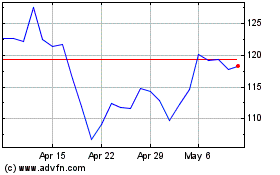Micron CEO's Plan to Stay Ahead of Coronavirus Started Coming Together in January
April 01 2020 - 8:29AM
Dow Jones News
By Asa Fitch
March probably felt like the longest month ever for many chief
executives. In a matter of weeks, the new coronavirus went from a
major disruption in Asia to a full-blown global pandemic that
shoved business-as-usual out the window.
Sanjay Mehrotra, chief executive of Micron Technology Inc., has
been weathering the storm for the past three months. The chip maker
has testing and assembly operations in China, so the 61-year-old
executive has been addressing Covid-19's toll since January.
He retooled procedures to keep production lines running. As a
result, Micron products have remained in supply as America
increasingly works from home--a migration that heightens demand for
the memory chips fueling the necessary tech infrastructure.
"We're doing our part in terms of being ahead on the curve," Mr.
Mehrotra said in an interview.
Micron started handing out protective gear to employees across
its many sites throughout Asia on Jan. 23. It started to take
employees' temperatures in the region the same day.
Realizing in early February that some disruption would be
unavoidable, Mr. Mehrotra deployed a "red team, blue team" approach
to working at its Asian factories. Micron sent two sets of teams
with overlapping skills to separate parts of facilities. If
individuals on one team fell sick, the other team stepped in,
minimizing stoppages and containing the spread of infection.
To avoid cross-contamination, red and blue teams were assigned
different entrances, cafeteria shifts and buses to go to and from
factories. Many people were moved onto work-from-home rotations to
reduce the number of people in factories at any given time.
Micron also set up backup remote-operating centers at all its
factories. That way, even if people working the machines got sick,
chip-making operations could keep running using automation.
Mr. Mehrotra assigned Manish Bhatia, the executive vice
president for global operations in Singapore, to oversee the
system.
Also in late January, Mr. Mehrotra investigated the supply chain
for potential choke points. Micron started to stock up on silicon
wafers--the thin substructure on which chips are built--and
industrial chemicals at its chip-making factories, allowing
production to continue even if raw materials became harder to
ship.
New suppliers were tapped to further mitigate disruptions.
The CEO's strategy was tested on March 18, after the Malaysian
government restricted movement and shut nonessential businesses.
This affected Micron's facilities that test and assemble chips.
The company joined other electronics producers and lobbied
Malaysian officials to be classified as essential, arguing that
memory and data storage products allow millions of people to work
from home. Micron pointed to its red-team, blue-team approach as a
way to manufacture chips safely. The government agreed and allowed
Micron and others to restart operations on a limited basis.
Similar efforts by the U.S. semiconductor industry to convince
state and federal governments that chip production is essential are
now under way.
"Managing the mix of this has been certainly challenging for our
team," Mr. Mehrotra said. "Things have been brought upon us, even
with the proactive work, rather suddenly."
The U.S. semiconductor industry has yet to face large
disruptions. Still, Mr. Mehrotra has rolled out the safety
precautions he created for Micron's Asian facilities at chip-making
factories and other key facilities in Idaho, Virginia and Utah.
The mix of products has also changed to reflect changing demand.
It has shifted production from memory for smartphones, where sales
are falling, to products for big data centers that support
cloud-computing services needed for remote work.
Last week, following a favorable earnings report, Mr. Mehrotra
said Micron would spend $35 million on initiatives that fight
coronavirus or blunt the financial pain the pandemic inflicts on
people. This plan includes $1,000 checks to U.S. employees making
less than $100,000 annually.
Mr. Mehrotra, of course, is by now a videoconferencing veteran.
Virtual happy hours are commonplace, and company leaders conduct
weekly calls with thousands of employees at a time. Nobody's
dressing formally these days. Mr. Mehrotra only puts on a button-up
shirt if he's going on television.
"I wear normal shirts, and I may be wearing shorts underneath,"
he said.
Write to Asa Fitch at asa.fitch@wsj.com
(END) Dow Jones Newswires
April 01, 2020 08:14 ET (12:14 GMT)
Copyright (c) 2020 Dow Jones & Company, Inc.
Micron Technology (NASDAQ:MU)
Historical Stock Chart
From Mar 2024 to Apr 2024

Micron Technology (NASDAQ:MU)
Historical Stock Chart
From Apr 2023 to Apr 2024
